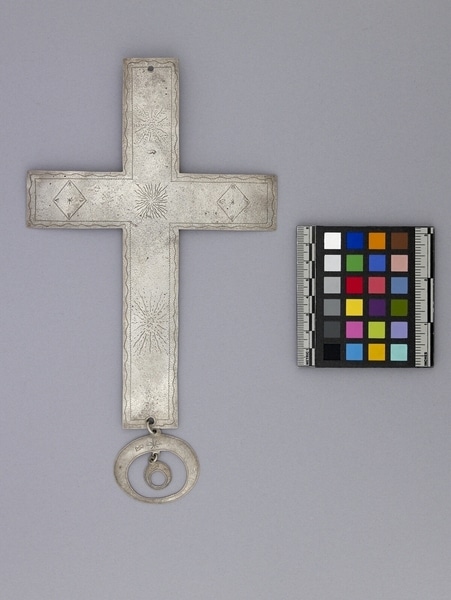Single Cross Item Number: 1590/299 from the MOA: University of British Columbia

Description
Single bar, thin, flat cross with square ends. Double zigzag lines form border. Three engraved sunbursts and two diamonds. Suspended from bottom are two concentric flat rings with zigzag line borders. The larger has an engraved sunburst. Cross and both rings stamped with maker’s mark.
History Of Use
Silver ornaments represent an important part of early exchange between Europeans, including fur traders, and First Nations peoples, especially in eastern and central Canada and the U.S.A. Initially, the main source of silver was British, French and Spanish coins. Most ornaments were produced by silversmiths of European origin in North America and Europe, and were actively traded only from 1760 to 1821. By the mid-18th century silver objects were produced in New England, Quebec and Montreal. Silver was used by First Nations peoples as a sign of rank. Silver ornaments in these styles continue to be produced by native silversmiths in central Canada and the U.S.A. The cross was the oldest form of trade silver, introduced by French missionaries to North America for presentation to converts. Crosses were later used as trade silver with no religious connotations. They circulated well into the 19th century and were worn on the chest. The Latin cross has a single bar.
Cultural Context
trade; personal decoration; status
Specific Techniques
Roulette engraving produces a uniform zigzag, an identifying feature of this technique, and is created by using a revolving disk with sharp teeth.
Item History
- Made by Joseph Mailloux in Quebec City, Quebec, Canada ? between 1760 and 1821
- Owned by Kathleen E. Reif before September 9, 1993
- Received from Kathleen E. Reif (Donor) on September 9, 1993
What
Who
- Culture
- Eastern Woodlands
- Creator
- Joseph Mailloux
- Previous Owner
- Kathleen E. Reif
- Received from
- Kathleen E. Reif (Donor)
Where
- Holding Institution
- MOA: University of British Columbia
- Made in
- Quebec City, Quebec, Canada ?
When
- Creation Date
- between 1760 and 1821
- Ownership Date
- before September 9, 1993
- Acquisition Date
- on September 9, 1993
Other
- Item Classes
- metalwork
- Condition
- good
- Current Location
- Case 45
- Accession Number
- 1590/0299